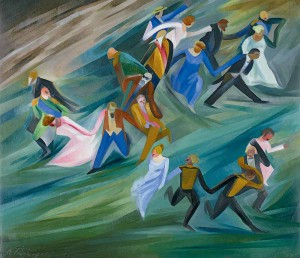Their leader and ideologue was Vasily Chekrygin. Whereas the constructivists desired to leave traditional easel painting behind and dismantle the very foundations of the visual arts, thereby transforming the principles according to which art functioned in modern society. Chekrygin aimed to have art be “spiritual,” i.e., standing on the very border of the material realm. The essence of his divergence from other schools of art was well formulated in Chekrygin’s diary entry from February 17, 1921: “Their coarse understanding of art was demands some sort of hitherto unseen method of painting using the objects themselves. Dear friends, by doing this you depart from the principles of painting and wreck its nature. And that is the worst form of obscure provincial decadence… I would call colour, light and sound the highest form of flesh. Creating with this flesh is not at all the same as creating a likeness; it is creation in the highest sphere and realm.” [4]
In 1922, exhibitions were first held by the New Society of Painters (NoZh) the Genesis Society (Bytie), and the Association of Artists of Revolutionary Russia (AKhRR). 1924 saw the formation of the Four Arts Society, which included masters from the older generation such as Petrov-Vodkin, Saryan, Kuznetsov and Istomin, as well as Favorsky, Miturich and Midler. The Society of Easel Painters (OST) was formed in 1925 and included artists such as Goncharov, Deyneka, Labas and Tyshler. Many young artists exhibited their work at OST exhibitions, including Schipitsyn and Zusman. The Moscow Artists’ Association was also formed in 1925. Its members included Drevin, Udaltsova, Falk, and Osmerkin. The Painters’ Workshop Society was formed in 1926; this society was comprised of students from the Higher Art and Technical Studios (Vkhutemas) who studied under A. Shevchenko.



